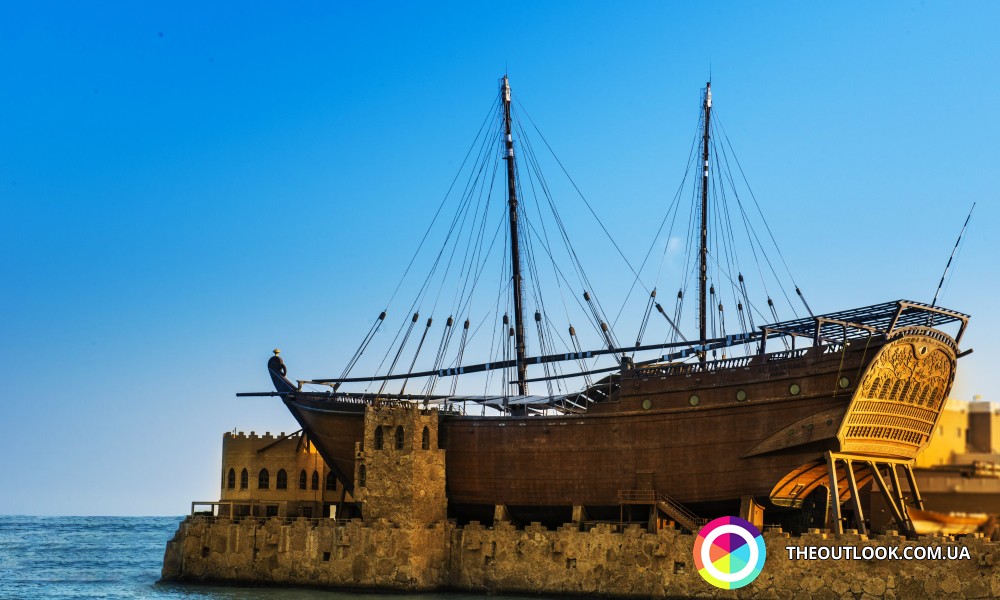Caravel will be built here: Ships born in Kuwait

The tribe with a strange name bani utub came to the territory bordering the bay, and began to construct buildings and produce pearls. Unlike neighbouring communities enthusiastic of constant showdowns with usage of primitive weapons, bani utub did not waste any time and immediately mastered the thing which in the language of modern marketing is termed a unique commercial offer. From that place one could move around the bay, launch advertisement moving by word of mouth, and attract buyers. Luckily, there were enough good: horses, spices, coffee and everything your heart desires. Kuwait obviously could become a commercial port, thus decided the most intelligent representatives of bani utub, and started an active shipbuilding. The first ships of Kuwait were built at the beginning of the 17th century, at the same time vessels with a wide assortment of cargo sailed in the direction of India and Africa.
Next tribe which allowed tailwind to inflate the sails, bore the proud name of atban. According to the German traveller Karmtena Nijboer, by 60’s of the 18th century Kuwait became the proud owner of eight hundred ships, timber used to build them was brought from India. Those days the tribes which repealed aspirations of the Ottoman Empire on the territory of Kuwait, did not know that their job would be a matter of national importance, and the ship in full sail in the arms of flotation ring, would be immortalized in the Emblem of Kuwait. Фото iles.tpg.ua
Фото iles.tpg.ua
By the way, the latter is just right for studying symbols and hidden meanings. Let's try to figure out what masters of heraldry meant? The ship bears image of tricolour flag; waves hinting at the proximity to the Persian Gulf, rest against the blue sky; the picture is completed with white ribbon tenderly holding state’s name on its expanses, only those in the know are able to read it since the words are neatly written in Arabic script. Sharp eyes will catch hold of the sprawled Falcon with a shield on the chest, the bird is a symbol of the Prophet Muhammad, and recalls that Kuwait celebrates the Muslim religion only.
The ship, which has become a national symbol, incorporates all facets of the Rubik's Cube - here are both nature and wonders of technology, and a respectful attitude toward Islam, and attention to traditions. Фото energyasia.com
Фото energyasia.com
No wonder that the residents of Kuwait venerate their vessel so much. At the end of the 19th century, the Kuwaiti flag hoisted on board of Ottoman ships, and then Sheikh Jaber was forced to pay taxes in amount of forty bags of rice and four hundred boxes of dates. Clever ruler decided that the Ottomans could be paid in another way, and provided many sailing vessels to conduct combat operations in defence of the Shatt al-Arab from the incursions of strangers. The victory in the important battle forced the Ottoman authorities to reconsider their attitude to Kuwait, and to pay a certain amount every month, not only out of gratitude to comrades, but also for the further development of the shipbuilding industry. That is how seniors and vassals reversed.
What happened then? The Persian Gulf remembers many ships leaving the coast of Kuwait, by the way, some of the vessel, especially significant for the history of the state, can be seen on the ground. Travellers who have visited Kuwait, usually take home miniatures of giant ship Al Hashemi II, at least, such a gift is considered a favourite souvenir of the tourists. The choice is clear: after seeing largest wooden ship in the world with their own eyes, foreigners sleep and dream how to erect in their kitchens at least a resemblance of the vessel.
This wooden disproportionate sailing vessel rises above the hotel Radisson SAS Hotel. Guinness World Records classified this shipbuilding miracle as the biggest dhow built of wood in the world. Arab caravel dhow was an ambitious project of one of the hotel owners Hussein Marathi, in memory of the businessman’s great-grandfather who had built a dhow named Al Hashemi. What else should we tell you about the national symbol of Kuwait? The ship is kept on nails and bolts, and is 30.4 meters long and 18.7 meters wide. Фото brownbook.me
Фото brownbook.me
Another ship worthy of public attention has a name of Baghala and was built in the 14th century. You can see the sight in Al Kuwait, but in order to decipher the name one need to look in the dictionary of Arabic words - then it turns out that Baghal translates as a mule. The gigantic size of this heritage attracted the compilers of the Guinness Book, who gave the ship Baghala title of the largest Arab boat dhow which can be found in the world. Many tourists staring at the ship are not embarrassed by and the fact that these vessels were widely used by pirates acting in the waters of the Persia or along the Arabian Peninsula.
...Those who like reading 1000 and 1 night before bedtime will remember how many Arab legends describe the entourage of the action: "And fresh wind is carrying dhow". It is not just a means of transportation, a consequence of technological progress or just artsy ship carrying pilgrims on the waves. It is also a kind of symbol bestowed to Kuwait by the Heaven, a country had not been broken under the pressure of time thanks to its rescue ships, which allowed to trade, to win battles, and just run through sea waves.
Cover photo api.ning.com





















